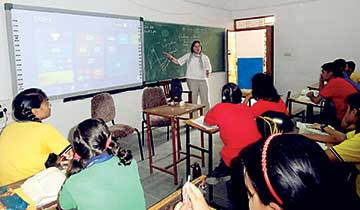Arun Khevariya
Educational excellence and continuous improvement is very essential to facilitate learning in today’s world to facilitate learning. Now no teaching community can flourish without adopting teaching tools like computers, the Internet and digital media. Teachers can create in the learners a thirst for knowledge through innovative practices and technology. This article looks at how teachers of English as a second language can use technology to their advantage.
Multiple intelligences is now a widely accepted theory and we know that children learn best if there is coordination among several types of learning inputs. I have found that a student becomes motivated if he receives learning inputs from various channels like classroom teaching, multimedia, Internet, audio visuals, computers, etc. Integration of digital resources like blogs, multimedia scrapbook, ESL Independent Study Lab, Filamentality Files, Subject Sampler Files, Hotlist**, etc., can be of great help to students to construct knowledge and achieve the higher goals of education. ICT based skills in language teaching can help in applying the best practices in the teaching of English as Second Language in the classroom.

Understanding a literary piece written in a foreign setting also becomes difficult if the learner is unaware of the setting and surroundings of that area. Students cannot fully appreciate a play, story or novel unless they are aware of the social, political, historical, geographical, and cultural circumstances of the country the story is set in. This problem too can be solved by integrating ICT in classroom teaching.
Preparatory work
Using ICT in the classroom requires teachers to plan well. In the preparatory phase topics are identified and hotlists (lists of relevant websites) are prepared. The students are then introduced to the topics. The steps involved in collecting data are explained. The students are divided into several groups and tasks are assigned to them.
Execution of the project
Students are engaged in collaborative learning. Groups consisting of 6-7 students are formed and they are required to collect different pieces of information regarding the topic chosen. Then the information is analyzed among group members and presented by the group leaders. The group members also perform the role of modifiers, and synthesize the new learning experience.
 The work involves teaching of English literature, language and communicative skills by harnessing the power of digital media, web resources, computers, interactive boards and Internet. The topics are explained with the help of educational resources available on the Internet. Students are asked to explore the available resources and prepare PowerPoint presentations on the basis of their acquired skills and knowledge thus acquired.
The work involves teaching of English literature, language and communicative skills by harnessing the power of digital media, web resources, computers, interactive boards and Internet. The topics are explained with the help of educational resources available on the Internet. Students are asked to explore the available resources and prepare PowerPoint presentations on the basis of their acquired skills and knowledge thus acquired.
Results
These activities will result in better writing skills and enhanced understanding of literature involving the study of social, political, historical, cultural perspectives. Students construct knowledge through a multi-disciplinary learning approach by using ICT.
Conclusion
Facilitation is the appropriate word to describe the overall impact of using ICT in the teaching – learning process. It helps students to be more enthusiastic, to explore, to solve problems and to construct knowledge. ICT helps in exploring the vast horizon of learning. It equips them with the power of out-of-the-box thinking. The use of interactive boards, interactive pads, digital recordings, blogging, etc., not only facilitates the learning outcome among students but it also helps them to come into contact with the teaching fraternity of various countries.
*This article is based on the author’s observation of ESL classes in Montana State University and various schools in Montana, USA during the Teaching Excellence and Achievement Program 2012.
**All web based applications for students to plan, organize and research on their topics of study.
The author has taught English to secondary school children in the USA. At present he is working as teacher of English in Kendriya Vidyalaya Sangathan, India. He has been a recipient of the KVS Regional Incentive Award. He can be reached at khevaria@rediffmail.com.
